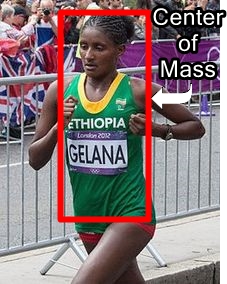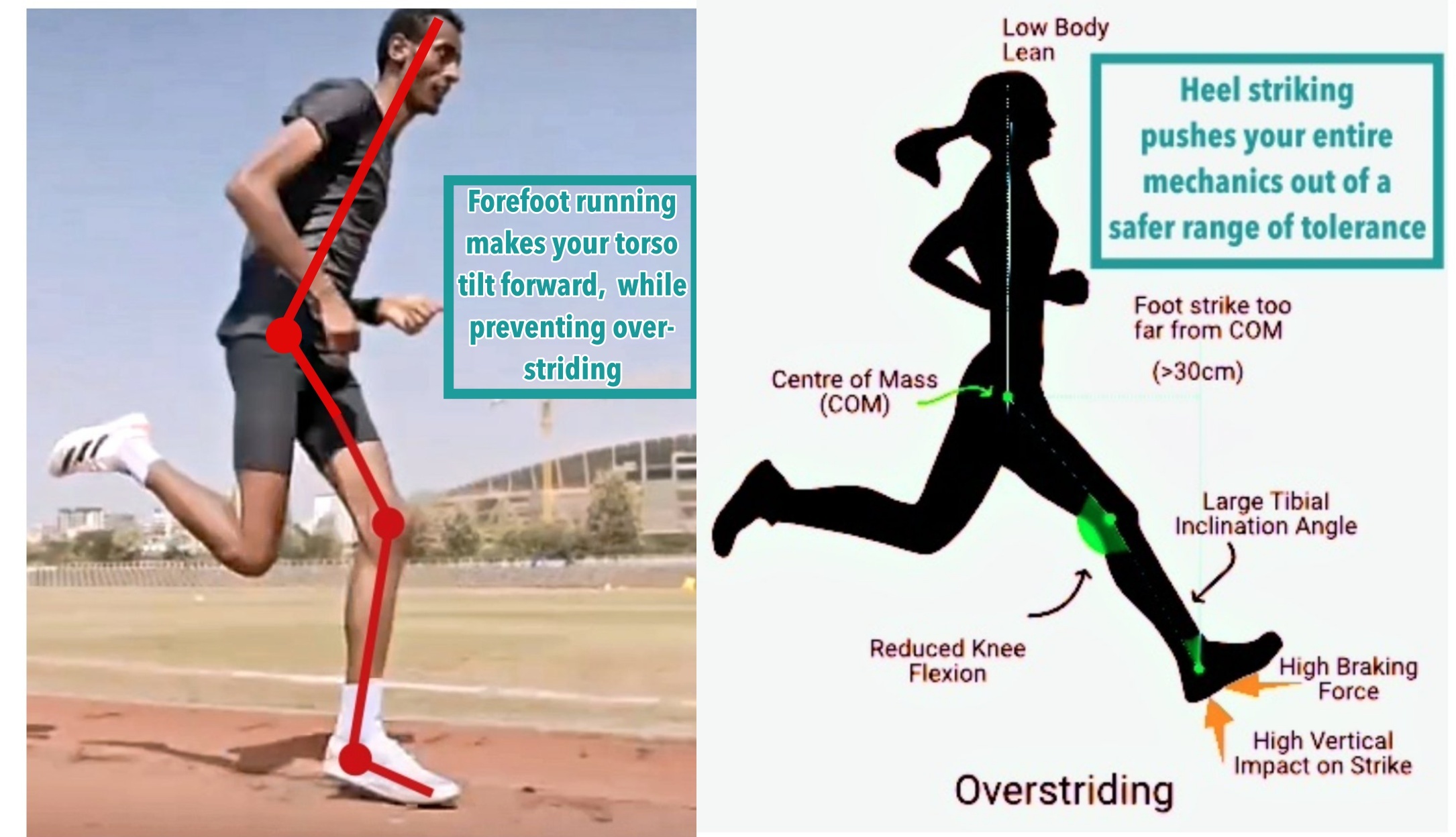In running, foot strike really matters because studies (references below article) have shown that how you land on your foot directly alters your entire body mechanics, torso position included. More specifically, foot strike pattern directly influences the position of your center mass (upper body) of which the position of your center mass is everything in running! The wrong position makes it more economically challenging and dangerous to run.
As mentioned above, the center of mass in running is the head and the torso, shown below:

A more scientifically-correct definition of the center mass is:
- The center of mass is an imaginary point at which the total body mass is concentrated, and it is a general descriptor of whole body mass movement.
The position of your torso/head during running significantly influences kinematics, mechanical work, impact production, metabolic energy expenditure whereby heel strike running and forefoot strike running involves different center of mass positions:
- Heel strike runners have a more posterior (backward; shown below) center mass position whereby the runner’s torso is kept farther behind initial foot strike position which was found to be a main source of stress because it results in excessive braking, compressive loading, and is ultimately why heel strike runners have the highest prevalence of every injury. These are the normal accompaniments of heel strike running as compared with forefoot running.
- Landing with a forefoot strike (shown below) causes the knee-joint to automatically bend at landing, which actually pulls the center mass slightly forward, thereby closing the distance between initial foot strike position and the center of mass. This plays a powerful part in both injury prevention and improved running economy by increasing forward momentum, while fully preventing many impact forces and a number of physically stress from reaching injury predisposing levels.

Injury
As mentioned above, heel strikers run more upright, causing a foot strike position to be in front of the knee (over-striding) and the center of mass , which ultimately creates braking and compressive forces on the knee-joint –this is how heel strike runners get runners knee.
To make running safer on the knees, the center of mass needs to travel parallel with initial foot strike position, meaning the center of mass must hover over the foot during touchdown. This configuration of the center of mass occurs in forefoot running and is achieved by allowing your whole body to lean or fall forward.
Maintaining Your Forward Lean
When running, focus on your torso/head moving forward first instead of reaching out with your leg at each step. That is, lead with your torso/head and then let your foot fall under the body to reduce braking.
- Focus on a weight-shift transfer in the forward direction when forefoot running. This will increase stride-rate and reduce ground reaction forces and shock attenuation.
The Take Home Message
Understanding the center of mass definition and how to position it properly during running will improve loading patterns at the ankle, knee and hip joints, and lowers metabolic cost, too.
In all, shifting the center of mass forward by adding a subtle body-lean to your forefoot running gait is a remarkably simple, yet precise technique to help you run better, and faster!
References:
Annoni et al. The effect of high-heeled shoes on overground gait kinematics in young healthy women. Sports Sci Health, 2014; 10:149-157.
Lormier, AV and Hume, PA. Achilles tendon injury risk factors associated with running. Sports Med, 2014; 44(10):1459-72.
Schuber, AG., Kempf, J and Heiderscheit, BC. Influence of stride frequency and length on running mechanics: a systematic review. Sports Health, 2014; 6(3):210-18.
Bretta Riches
BSc Neurobiology; MSc Biomechanics candidate, ultra minimalist runner & founder of RunForefoot. I was a heel striker, always injured. I was inspired by the great Tirunesh Dibaba to try forefoot running. Now, I'm injury free. This is why I launched Run Forefoot, to advocate the health & performance benefits of forefoot running and to raise awareness on the dangers of heel striking, because the world needs to know.
Latest posts by Bretta Riches (see all)
- Heel Lifts Increase Injury in Runners - 16/04/2024
- Are Minimalist Shoes Good for Seniors? YES! - 14/04/2024
- BIG Deals On Running Gear And More! - 09/04/2024

Leave a Reply